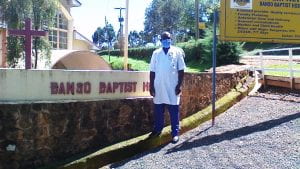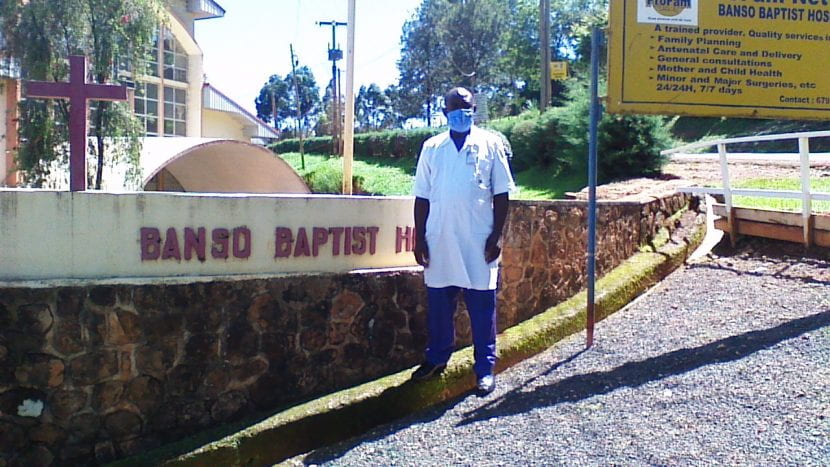Our first blog of 2021 is by Nkwan Jacob Gobte, of Cameroon Baptist Convention Health Services.
Jacob is the Research Coordinator of a hand hygiene study being led by the SHIP team in Cameroon.

Since the 18th century, hand hygiene has been widely accepted as the main strategy to prevent infections in healthcare facilities. Hand hygiene is the act of eliminating dirt or microorganisms from the hands by washing with soap and running water, or rubbing with alcohol based hand rub (ABHR). Unfortunately, despite efforts to promote hand hygiene, compliance has remained unacceptably low in most facilities, contributing to high prevalence of healthcare associated infections (HAIs) and antimicrobial resistance (AMR). Although, ABHR has been accepted and widely used for many years, it is not available at the point of care (POC) in many health facilities in Cameroon. Many studies have shown that providing ABHR at the POC, close to where it is needed, improves hand hygiene. This is something we wanted to do in Banso Baptist Hospital (BBH).
BBH is a tertiary referral hospital run by the Cameroon Baptist Convention Health Services. It is located in the North West Region of Cameroon, in a town called Kumbo. Average annual outpatient department consultations stood at 90,000 patients per year before 2016, but the number has significantly dropped after 2016 due to the ongoing socio-political crisis. Although ABHR has been in use in this facility since 2003, it has been in 100ml containers in healthcare workers’ pockets. It had not been available at the patients’ bedside, at the POC, before this project commenced. The goal of this project therefore was to introduce ABHR at the POC and monitor its effect on hand hygiene compliance, HAIs and AMR.

We followed the World Health Organization’s framework for hand hygiene which uses multiple strategies to improve hand hygiene with an emphasis on behaviour change. The framework has five components which include: ‘system change’, ‘training and education’, ‘reminders in the work place’, ‘evaluation and feedback’, and ‘institutional safety climate’. A before and after study design was used. We started collecting hand hygiene compliance data, and continued to observe throughout the nine month duration of the study. Multiple interventions were implemented in the second phase beginning with training of the staff, followed by introduction of ABHR at the POC, and feedback on hand hygiene compliance. We are in the last phase of the study after which hand hygiene compliance before and after the interventions will be compared to determine the effects of the interventions on hand hygiene compliance, HAIs, and AMR. However, provisional results indicates that hand hygiene compliance improved slightly during baseline from May to July 2020, but rapidly during the intervention phase, from August to October 2020 as a response to training, provision of ABHR at the POC, and regular monitoring and feedback to staff on their hand hygiene compliance rates.
My role was to coordinate the study, organise trainings for unit staff, organise hand hygiene observations, coordinate data collection, and enter and analyse data collected each week to identify trends. I have learnt many lessons from this experience.
I was surprised at how quickly staff accepted and appreciated the use of ABHR at the POC and that staff took it upon themselves to tell patients and caregivers to also use the ABHR. The combination of provision of ABHR at the POC combined with training, and continuous monitoring and feedback dramatically improved staff’s hand hygiene compliance. Hand hygiene compliance increased among all staff irrespective of their cadre and level of training. As hand hygiene compliance increased so did the volume of ABHR used. Having ABHR at the POC made it easier for staff, patients and carers to use it but it also served as a reminder to use it.
Some of the challenges I faced were, when the staff were particularly busy the bottles of ABHR were not always refilled, as this required staff to leave the unit and pick up supplies from the pharmacy. Also, although the hospital administration readily agreed to prepare and mount the ABHR holders and also permitted staff to do the hand hygiene observations without asking for financial compensation, it took some time to find the resources to do this.
I learnt that although most staff quickly understood the training and were able to apply this in practice, for a small number of staff this took longer. However, with continuous monitoring and feedback and a second training session using different teaching strategies all staff were eventually able to do so. I discovered that although the ABHR is mounted on the wall next to patients’ beds, they are not readily accessible from all sides of the bed. If I were to introduce ABHR in other units, I would mount it at the foot of bed and also place it on all trolleys that are used for patient care.
I think this project has been successful because of the adequate preparation and training the local research team received from Infection Control Africa Network (ICAN) and Glasgow Caledonian University (GCU), support from GAMA who donated the ABHR, and the commitment to the project from the local research team, clinical staff and hospital administration and management.
This study was funded by GCU’s Global Challenges Research Fund.
To find out more about the SHIP team, head on to the GCU website, read the rest of our blogs and follow us on Twitter @SHIPGCU
